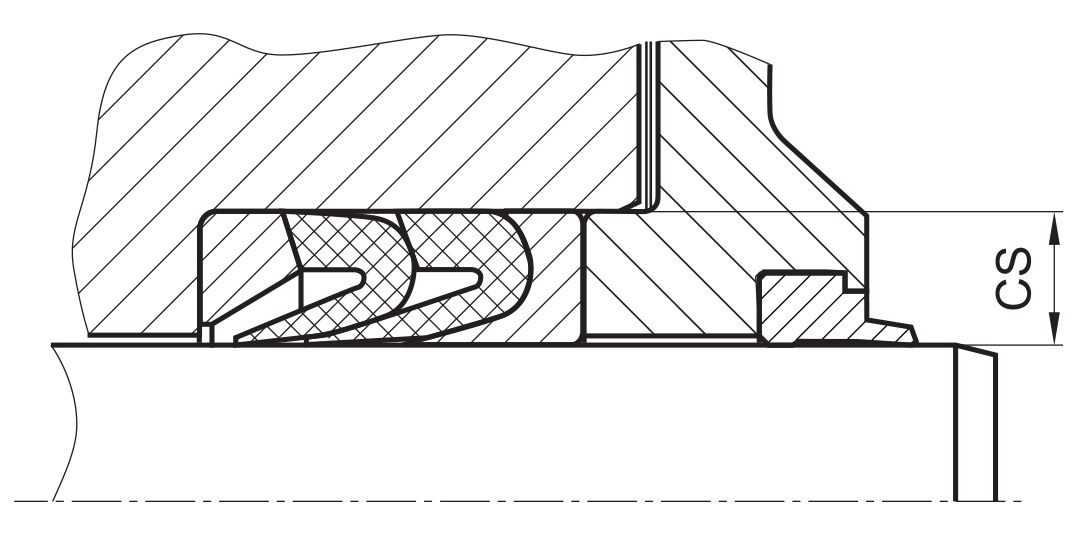

description
chevron set, design with extremely flexible sealing lips for difficult operating condi- tions (bad guiding, large tolerance range). available as total chevron set as well as intermediate chevrons only (in case of metal male and female adaptors).
- asymmetric single-acting rod sealing set consisting of several chevrons, com- bined with pressure and support ring to form a set. pressure and support ring are mainly made of metal or already integrated in metal housing.
- various materials are available for different purposes.
- good sealing in the higher pressure range.
- for pressures up to 500 bar as a seal between pressurised space and atmosphere.
- good static and very good dynamic sealing.
- suitable especially for very long travel.
- low friction due to flexible lip design.
- open, preferable adjustable mounting space required (see mode of installation).
- by varying the number of packings,friction as well as leakage behavior can beinfluenced (at least 2 chevrons).
- mainly used for repair purposes.use more modern systems for new designs.
- the long,flexible lip can compensate guide clearance (e.g.: on long strokes).
- due to the low contact pressure on the sealing lip surface,the piston can moveback easily.
application
not bolded symbols; please consult our technical for application limitations
category of profile
machined only.
single acting
the RS 32 seal is designed for use as a rod seal.
area of application: hydraulics
- linearly acting rods on hydraulic cylinders; plunger in down and upstroke presses.
- spindle seal at valves (at fittings).
- cylinders with very long strokes,e.g. lifting ramps or hydraulic elevators.
note
- expensive and complex design.
- former designs mainly made in fabric reinforced rubber.replacing such fabric reinforced rubber seals by polyurethane seals will
reduce the lubricating film (attention in case of more sealing rings).
- reworked housings (changed cross-section) require adapted pressure and support rings made of plastic. if this is not possible (if pres-
sure and support rings are integrated in the housing), it is recommended to consult our technical department for clarification.
Function
RS 32 profiles are single-acting rod seal sets designed to seal pressurized space against the atmosphere; mainly for reciprocating move- ments. the design is based on application in standard hydraulic systems with conventional hydraulic oils. the operating parameters are as defined in the sealing data sheet and material data. requirements deviating from these parameters can be met to a certain degree by changing the geometry in the software program.
operating parameters & material
| material | back-up ring | temperature | max. surface speed | max. pressure 1 | hydrolysis | dry running | wear resistance |
| PU | POM / PA | -30 °C … +100 °C | 0,5 m/s | 500 bar (50 MPa) | – | + | + |
| HPU | POM / PA | -20 °C … +100 °C | 0,5 m/s | 500 bar (50 MPa) | + | + | + |
| LTPU | POM / PA | -40 °C … +100 °C | 0,5 m/s | 500 bar (50 MPa) | – | + | + |
| SPU | POM / PA | -20 °C … +100 °C | 0,7 m/s | 500 bar (50 MPa) | + | + | + |
| CPU | POM /PA | -30 °C … +100 °C | 0,5 m/s | 500 bar (50 MPa) | + | + | + |
the stated operation conditions represent general indications. it is recommended not to use all maximum values simultaneously. surface speed limits apply only to the presence of adequate lubrication film.
1 pressure ratings are dependent on the size of the extrusion gap.
2 POM up to ø260 mm, PA above ø260 mm
++ … particularly suitable o … conditional suitable
+ … suitable – … not suitable
for detailed information regarding chemical resistance please refer to our „list of resistance“. for increased chemical and thermal resistance rubber
materials in other systems are to be preferred, attention should be paid to restrictions for pressure range and wear resistance. for higher gliding speeds another system should be used (e.g. PTFE materials).
gap dimension
when using a pressure ring, the extrusion gap is already integrated in the seal. the gap between piston rod and housing should not exceed cs·0.05.
surface quality
| surface roughness |
Rtmax (μm) |
Ra (μm) |
| sliding surface | ≤2,5 | ≤0,1-0,5 |
| bottom of groove | ≤6,3 | ≤1,6 |
| groove face | ≤15 | ≤3 |
tolerance recommendation
| seal housing | tolerances |
| Ød | f8 |
| ØD | H10 |
mode of installation
insert the male ring first, then the packing and finally the pressure ring (well greased) into the installation space. insert the metal insert without load, complete mounting of the system, tighten metal inserts slightly, let run in (10 to 20 idle strokes). finally tighten the metal insert to nominal height.
recommended mounting space:

the adjustment range of the mounting space height (L) should correspond to approx. 10% of the theoretical mounting length.
| d f8 [mm] |
p ≤ 100 [bar] |
100 < p ≤ 200 [bar] |
p > 200 [bar] |
| ≤ 100 | H10 | H8 | H8 |
| > 100 ≤ 200 | H10 | H8 | H7 |
| >200 | H9 | H8 | H7 |
insertion chamfer:
in order to avoid damage to the rod seal during installation, the piston rod is to be chamfered and rounded as shown in the “recommended mounting space” drawing. the size of chamfer depends on the seal type and profile width.
| cs (mm) | c (mm) | |
| α = 15⁰ … 20⁰ | α = 20⁰ … 30⁰ | |
| 4 | 3.5 | 2 |
| 5 | 4 | 2.5 |
| 6 | 4.5 | 3 |
| 7.5 | 5 | 4 |
| 10 | 6 | 5 |
| 12.5 | 8.5 | 6.5 |
| 15 | 10 | 7.5 |
| 20 | 13 | 10 |
seal & housing recommendations
please note that we are able to produce those profiles to your specific need or any non standard housing. for detail measurements, please see Jet seal pars catalog…

this profile is only a replacement in already existing housings. use new sealing systems in new designs. the nominal width and seal diameter should be in accordance with following recommendations:
| cs = (ØD – Ød)/2 [mm] | L [mm] |
| 8 | 4 |
| 9 | 5 |
| 11 | 6 |
| 14 | 7.5 |
| 17 | 10 |
| 20 | 12.5 |
| 25 | 15 |
| 32 | 20 |
fitted:

don’t hesitate to contact our technical department for further information or for special requirements (temperature, speed etc.), so that suitable materi- als and/or designs can be recommended.
